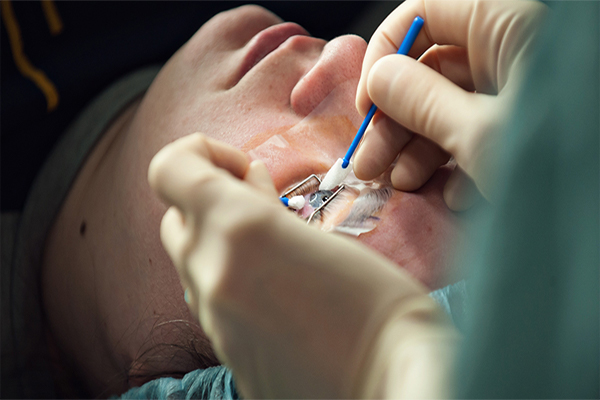Table of Contents
LASIK surgery is one of the most common laser surgeries performed to correct vision problems and refractive errors of the eye and will be a good method as an alternative to glasses. During LASIK surgery, the doctor reshapes the corneal dome with a special type of laser that improves the patient’s vision. The cornea naturally bends light on the retina at the back of the eye, but if the eye has disorders such as myopia, farsightedness, and astigmatism, it bends the light incorrectly, resulting in blurred vision. In this article, we will explain LASIK eye surgery and its stages from Moj Aramesh Amitis Health Tourism Company.

Use of LASIK
LASIK surgery can correct some vision problems such as myopia, hyperopia, and astigmatism. However, contact lenses and glasses can also improve a person’s vision; But by changing the shape of the cornea, refractive errors can be corrected and eliminated. The following is a brief definition of the terms used to describe a person’s vision.
- Hyperopia
When the cornea of the eye is too flat or the eyeball is smaller than average, it focuses on the back instead of focusing on the retina. This disorder causes nearsightedness and sometimes farsightedness. In this case, the person in question has a clear view of distant objects and people and will not have a clear view of close people and objects.
- Astigmatism
When the cornea is roughly curved and flattened, it causes astigmatism, leading to blurred vision near and far.
- Myopia
When the cornea is larger than usual, the curve becomes slightly larger than normal; As a result, you will see objects that are close by clearly and distant objects blurred.
LASIK Pre-Operative Instructions
According to the medical community, LASIK eye surgery is a choice surgery. For this reason, most insurance companies do not cover the cost of this surgery. Therefore, you must prepare the cost of surgery before deciding whether to perform the procedure.
On the day of LASIK surgery, avoid makeup, especially eye makeup. You may also need to clean your eyes from dirt and debris for a few days before regular surgery as recommended by your doctor to prevent eye infections.
If you wear contact lenses, you should not wear them for a while before LASIK surgery and only wear glasses. During an ophthalmological visit, a general eye examination is performed to make sure that your doctor is a good candidate for LASIK surgery.
If you experience symptoms such as eye infection, inflammation, dry eyes, large pupils, and high eye pressure during the assessment, it indicates that you will not be a good candidate for LASIK eye surgery. Before LASIK surgery, your doctor will inform you of the risks and benefits of surgery and surgical outcomes.
LASIK Procedure in Details
LASIK eye surgery usually takes 30 minutes or less. You will be given a sedative before surgery. During surgery, anesthetic drops are used inside the eye, and your eyelids are kept open during the operation using a special tool.
Your vision may become a little blurry due to putting a ring on the cornea for better vision. The surgeon then cuts a small flap from the front of your eye using a laser or small blade. By folding or retracting part of the flap, the doctor can access the part of the cornea that is intended to deform and the parts of the cornea that need to be reshaped.
After the shape of the cornea has been corrected, the flap tissue will be in place. During LASIK surgery, your doctor will ask you to look at a specific point. Because you can keep your eyes steady so that it doesn’t move during corneal surgery and the corneal deformity is done properly.
When the laser is removing corneal tissue, you may feel a smell similar to burning hair. If both eyes have vision problems, they will usually be corrected at the same time.
LASIK Post-Operative Instructions
After LASIK surgery, you may experience some itching, burning, blurred vision, and tears. You may also have some pain, but blurred vision goes away quickly and vision improves. After surgery, use painkillers as recommended by your doctor to reduce pain.
You should use an eye protector when sleeping at night. After the surgery, your vision is not clear and it may last for about 2 to 3 months to improve your vision level. About one to two days after surgery, you should be examined again by your doctor to check for recovery and complications.
For this reason, you should visit your doctor regularly for up to six months after surgery. You won’t be able to wear cosmetics around your eyes for a few weeks after surgery. You should also avoid contact sports such as swimming and jacuzzi for a few weeks.
Possible Complications of LASIK Surgery
Some side effects of LASIK eye surgery, especially dry eye and temporary vision problems such as dizziness, are more common. But the side effects that cause vision loss after LASIK are very rare. Temporary complications of LASIK surgery that usually resolve after a few weeks or months are:
- Dry Eyes
After LASIK surgery, you will see a temporary reduction in tear production, and for six months or more after LASIK, you may feel a slight dry eye. These conditions reduce the quality of vision. To control dry eye, your specialist doctor will prescribe eye drops; But if your dry eye is severe, your doctor will consider another way to prevent the tears from draining.
- The duality of vision and glare
After LASIK surgery, you may experience dual vision, light sensitivity, and halos around very bright light for days or weeks. In addition, even when your recovery is largely achieved, your vision in low light and dark may still be reduced.
- Improper corneal correction
If the corneal tissue is not corrected properly during LASIK surgery and a little tissue is removed from the cornea, the vision will improve slightly. Incorrect corneal correction is more observed for people who are myopic and may require pre-surgery after a year.
- Excessive Correction
Corneal tissue may change more than usual during LASIK surgery. Over-corneal correction is more difficult than incorrect corneal correction.
- Astigmatism
When the corneal tissue is removed unevenly, the patient develops a condition called astigmatism, which can lead to blurred vision. In such cases, the patient is forced to wear glasses or contact lenses, and in more severe cases, reoperation is possible.
- Flap problems
When the flap is removed or folded in front of the eye during LASIK surgery, it may cause an infection or produce extra tears. The outer layer of the cornea may also overgrow during normal healing.
- Reduced or Loss of Sight
Complications that rarely occur after LASIK surgery include vision loss and decreased vision levels.
- Visual regression
When the patient’s vision returns to its original level after LASIK surgery, the patient will have a visual regression. This complication is also rare after LASIK surgery.
Conditions that increase the complications of surgery:
Some conditions can increase the possibility of possible complications that may occur after LASIK surgery or change the outcome of surgery, including:
- Autoimmune disorders such as rheumatoid arthritis
- Continuous dry eye
- Weakened immune system due to the use of immunosuppressive drugs or AIDS
- Change in vision level due to drug use, pregnancy, lactation, and aging
- Corneal inflammation and damage to the eyes, glaucoma, and cataracts
For whom is LASIK surgery not suitable?
- People with an eye disease that causes thinning and bulging corneas.
- People with large pupils or thin corneas.
- People who have visual impairments such as low vision due to aging
- People with relatively good vision.
people who do exercises that lead to eye trauma.

Result of LASIK Surgery in Iran
After LASIK eye surgery in Iran, you will not need glasses or contact lenses, and your vision level will improve after a while. Eight out of 10 people who have LASIK surgery do not need to wear glasses or contact lenses after surgery. Although the outcome of LASIK surgery depends on the level of vision and various other factors; But people with low-grade myopia will get the best results from LASIK surgery, and people with high-grade myopia and astigmatism will have less predictable surgical outcomes. In general, most people who have LASIK surgery in Yaran gain 20/20 vision; But as people get older, they will need glasses when driving at night and studying.
Concluding Remarks
For accurate treatment of eye problems that have not been treated by other methods, a specialist doctor recommends LASIK eye surgery. LASIK is a common treatment that corrects refractive eye defects and other corneal or lens irregularities. This surgery aims to correct the level of vision that can be seen in the shortest possible time. LASIK surgery will be a painless operation that usually lasts 15 to 30 minutes. Within 24 hours of surgery, the patient’s vision will be fixed and for several months he will experience blurred vision, which will disappear over time and the level of vision will improve significantly compared to before LASIK surgery.
Author: Sh. Khazaei
Translator: N. Rahimifar




